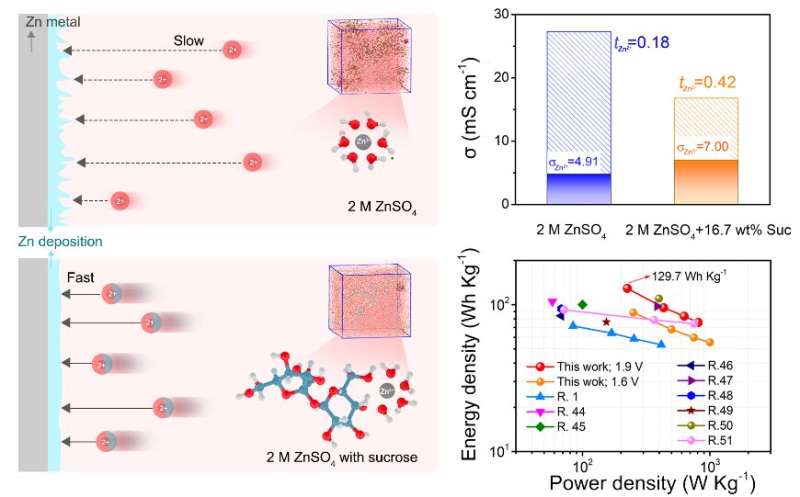Nano ResearchTsinghua University” width=”800″ height=”497″/>
Researchers designed a sucrose-modified aqueous electrolyte that increases the mobility of zinc ions in response to the electric field and successfully achieves dendrite-free zinc batteries without compromising electrochemical performance. Credit: Nano-researchTsinghua University
Due to their low cost and environmental friendliness, aqueous zinc batteries have the potential to play an important role in future energy storage systems for applications such as power grids. However, a security issue has slowed the progress of this emerging technology.
In a July 28 study published in Nano-researchChinese researchers presented a solution in which common table sugar is chemically modified to stabilize the zinc ion environment and secure future applications.
From electric cars to wind and solar power systems, an increasingly diverse array of energy-hungry applications continues to drive demand for large-scale, low-cost energy storage. Aqueous Zinc (Zn) batteries quickly emerged as one of the more promising options for meeting demand sustainably, according to the research.
“They are very safe and cost-effective compared to current lithium-ion batteries with flammable organic electrolytes,” said author Meinan Liu, an associate professor of nanotechnology and nanobionics at the University of Science and Technology of China. “In addition, the Zn anode has a super-high theoretical capacity, which makes these Zn batteries even more promising for applications such as future energy storage in the power grid.”
However, when the zinc ion (Zn2+) concentration on the surface of the anode drops to zero, dendrites begin to grow. Uncontrolled Zn dendrite growth impairs electrochemical performance and poses a serious threat to safe operation.
“These dendrites can penetrate the separator and short-circuit the battery,” Liu said.
Previous studies have shown that adjusting the solvent environment (termed “solvation structure”) increases the mobility of Zn. can enlarge2+ in response to the electric field successfully suppresses the growth of dendrites. The problem was that these previous adjustments — such as introducing other salts or incorporating fewer water molecules — also ultimately reduced the system’s ionic conductivity.
There was a fundamental understanding gap between Zn2+ solvation structure and its mobility, explained by Liu. This was a key factor affecting dendrite growth and stability of the Zn anode.
In an effort to bridge this gap, a collaborative research team from multiple Chinese institutions tried a new approach: introducing regular table sugar with multiple hydroxyl groups (a hydrogen and an oxygen bonded together) into the electrolyte to modify the solvation structure of Zn. .2+.
By conducting atomistic simulations and experiments, the research team confirmed that the sucrose molecules improved mobility and halted dendrite growth without compromising stability. In fact, this method also offered unexpected benefits:
“Findings confirm that sucrose molecules in the solvation coat not only improve mobility but also provide fast Zn2+ kinetics, but also protects the Zn anode from water corrosion and successfully achieves Zn dendrite-free deposition and suppression of side reactions,” said Liu.
This demonstrates the great potential of using this simple sucrose modification for future high-performance zinc batteries and brings the research field one step closer to the ultimate goal of achieving a safe, green, high-performance Zn battery.
“Hopefully this safe, low-cost Zn battery can be applied to power grid storage,” said Liu.
This technique also lends itself to additional variations and modifications: Zn carbon cells deliver higher energy density and improved stability, indicating great potential application of sucrose-modified electrolytes for future Zn batteries.
In future studies, the researchers will also consider potential use cases and roadblocks for aqueous zinc batteries, particularly how they can handle extreme temperatures.
“The aqueous electrolyte of the Zn battery will be frozen at a low temperature, so we are investigating how to address the temperature influence on battery performance,” said Liu.
Yufang Cao et al, Fast Zn2+ mobility enabled by sucrose modified Zn2+ solvation structure for dendrite-free aqueous zinc battery, Nano-research (2022). DOI: 10.1007/s12274-022-4726-3
Provided by Tsinghua University Press
Quote: Common Table Sugar Key to Eliminate Safety Risks in Aqueous Zinc Batteries (July 2022, July 29) Retrieved July 30, 2022 from https://phys.org/news/2022-07-common-table-sugar-key-allaying.html
This document is copyrighted. Other than fair dealing for personal study or research, nothing may be reproduced without written permission. The content is provided for informational purposes only.

